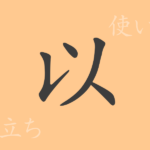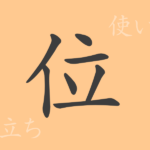“
The beauty of the Japanese language lies in its complexity and the richness of expression found within each Kanji character. One such character deeply ingrained in our daily lives is ‘衣’ (I). This article delves into the rich meanings and history of the Kanji ‘衣’, exploring its role in our lives from its origins to modern-day usage.
Origins of 衣 (I)
The Kanji ‘衣’ originated in ancient China, used to denote clothing. Its original pictograph depicted a person donning clothes, with the upper part representing the head and the lower part symbolizing the garment. Over time, its form evolved into the current ‘衣’, reflecting the fundamental act of wearing clothes and its significance across various cultures and customs.
Meaning and Usage of 衣
The primary meaning of ‘衣’ encompasses clothing or garments. Beyond this, it broadly signifies anything that covers or protects. As a verb, it transforms into ‘衣る’ (Ki-ru), meaning ‘to wear’ or ‘to clothe oneself’. In Japan, the practice of seasonal wardrobe changes, known as ‘衣替え’ (Koromoga-e), often involves this character.
Readings, Stroke Count, and Radical of 衣
The Kanji ‘衣’ has multiple readings and structural characteristics within the Japanese language.
- Readings: The On’yomi (on reading) is ‘I’, while the Kun’yomi (kun readings) include ‘Koromo’ and ‘Kinu’.
- Stroke Count: The character ‘衣’ consists of 6 strokes.
- Radical: The radical for ‘衣’ is itself ‘衣’ (Koromohen).
Phrases and Proverbs Using 衣
Many idioms and proverbs incorporating ‘衣’ exist within the Japanese language, each illustrating the cultural depth of this character. For example, ‘衣食住’ (Isyokuzyuu) refers to the essentials of life: clothing, food, and shelter. ‘衣冠束帯’ (Ikansokutai) suggests that professional matters should be left to the experts, akin to the saying ‘蛇の道は蛇’. Additionally, ‘衣の下に出る’ (Koromo-no-sita-ni-deru) signifies becoming independent and leaving one’s parental home.
Summary of 衣
The meaning imbued within a single Kanji character reflects the depth of the culture and history of its use. ‘衣’ not only refers to clothing but also influences people’s lives and spirituality. Its significance remains vibrant in modern times, continuing to enrich our language and actions. As we move forward, it is essential to cherish and carry forward the rich world represented by ‘衣’.
“

























